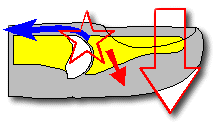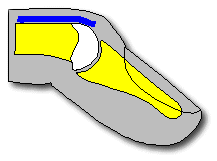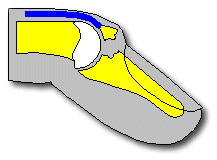| What is it? |
-
Mallet finger refers to a condition in which the end joint of a finger
bends but will not straighten by itself. In this situation, the joint
can be pushed straight but will not hold that position on its own.

|
| What caused it? |
-
The mechanism which straightens the end joint has been disrupted. This
usually happens when the tip of the finger is pushed down while the person
is trying to straighten their finger:

-
The tendon which pulls on the end bone to straighten the finger pulls one
way, and the force on the end of the fingertip pulls the other way, and
something comes apart in between. Often, the tendon tears away from its
attachment to the bone:

-
Sometimes, the tendon comes off with a piece of bone attached:

-
In worse cases, the tendon comes off with a fairly large piece of bone,
which can make the rest of the joint slide out of alignment. Fortunately,
that is not very common.
|
| What can you do to help? |
-
Don't just ignore it. Some people ignore a bent finger, assuming that it
will straighten out on its own. This is unlikely to happen. The longer
the finger stays bent, the harder it will be to fix.
|
| What can a therapist do to help? |
-
Most mallet fingers can be treated by a therapist, who can provide a comfortable
splint to straighten the finger, and exercises later on if stiffness is
a problem. A good splint is important, because proper treatment involves
wearing the splint continuously for a long time.
|
| What can a doctor do to help? |
-
Confirm that this actually is the problem.
-
Prescribe hand therapy and a custom prescription splint.
-
In some cases, perform surgery to reconstruct the attachment of the tendon.
This type of surgery is usually not necessary unless the injury is from
a cut on the back of the finger
-
If the finger can not be maintained straight with splinting, it may be
helpful for the surgeon to place a temporary metal pin in the finger to
hold the joint straight and act as an "internal" splint - usually for about
six weeks.
-
After any surgery, therapy and further splinting may be needed for several
months more.
|
| How successful is treatment? |
-
Although this may seem like a trivial or simple injury, a cosmetically
perfect correction is not likely with any form of treatment. However, with
proper therapy and effort on the part of the patient, this problem can
usually be improved to a tolerable level most - that is, the end joint
of the finger may not fully straighten, but it will work well enough to
be used for normal activities.
-
Unless the injury is due to a cut on the back of the finger or there is
some other associated problem, many hand surgeons believe that the final
outcome and complication rate are at least as good with splinting alone
compared to surgical repair. This may change as new techniques are developed
to improve the results of surgery.
-
Surgery is a reasonable consideration if the finger remains unacceptably
bent after a full trial of splinting or if splinting is not possible -
for example, if a skin reaction develops beneath the splint. Surgery is
only considered if the outcome of surgery is expected to be better than
the outcome of treatment without surgery.
|
| What happens if you have no treatment? |
-
Without any treatment, the appearance and ability to straighten the end
joint of the finger will not improve. Additionally, if the injury is less
than a month old, the problem may be worsened by using the finger without
a protective splint of some sort.
-
If the injury is more than three months old and has not been treated, it
is unlikely that it will get better or worse on its own. Injuries more
than three months old are not likely to be improved with anything short
of surgery.
|
|



